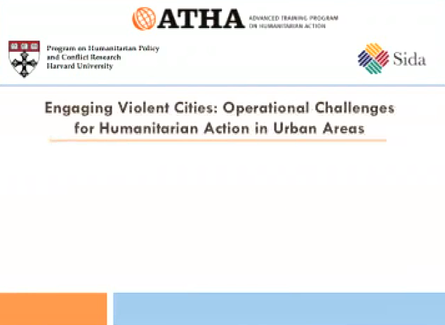
In the year 2008, for the first time in history, more than half of the world’s population was living in urban areas. Cities have become more numerous, more populous, and denser. The complexity and density of urban environments significantly alter the viability of certain humanitarian protection strategies that might work well in rural, more sparsely populated areas. In addition, it has become difficult to draw the line between acute and chronic vulnerability and therefore, the identification of beneficiaries.
This blur in distinction between chronic and acute vulnerability has raised a number of important questions for humanitarian organizations regarding if and how they should intervene. While many such organizations are equipped with the appropriate skills to mitigate overwhelming public health challenges is such contexts, the absence of a crisis point - such as armed conflict or natural disaster - brings the mandate of humanitarian agencies into question. Despite challenges, many organizations are moving forward with such interventions in the name of the humanitarian imperative.
Heretofore, humanitarian organizations have adopted internal ad-hoc decision-making processes for determining whether or not to intervene in a particular context based on their own understanding of their added value. But the challenges of mass urbanization require a more systematic approach.
This Webcast will explore these decision-making processes to delve into several questions that must be dealt with as humanitarian actors move forward with such interventions, especially in violent cities:
• How do humanitarian organizations determine where to act, and what type of events trigger the need to intervene? • What are the measures of vulnerability and how do humanitarians assess their impact in violent cities? • How do humanitarians interact with local authorities and build networks within the community? • Before deciding to intervene, do humanitarian actors contemplate what an appropriate exit strategy would look like?
Resource collections
- Coordination
- Evaluating humanitarian action
- Topics
- UN Habitat - Urban Response Collection
- Urban Response - Urban Crisis Preparedness and Risk Reduction
- Urban Response Collection - Community Engagement and Social Cohesion
- Urban Response Collection - Economic Recovery
- Urban Response Collection - Environment and Climate Change
- Urban Response Collection - Housing, Land and Property
- Urban Response Collection - Urban Crisis Response, Recovery and Reconstruction
- Urban Response Collection - Urban Resilience
